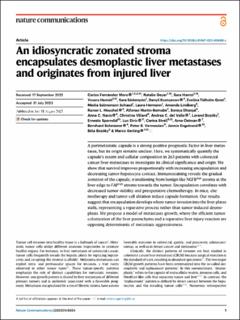| dc.contributor.author | Fernández Moro, Carlos | |
| dc.contributor.author | Geyer, Natalie | |
| dc.contributor.author | Harrizi, Sara | |
| dc.contributor.author | Hamidi, Yousra | |
| dc.contributor.author | Söderqvist, Sara | |
| dc.contributor.author | Kuznyecov, Danyil | |
| dc.contributor.author | Tidholm Qvist, Evelina | |
| dc.contributor.author | Salmonson Schaad, Media | |
| dc.contributor.author | Hermann, Laura | |
| dc.contributor.author | Lindberg, Amanda | |
| dc.contributor.author | Heuchel, Rainer L. | |
| dc.contributor.author | Martín-Bernabé, Alfonso | |
| dc.contributor.author | Dhanjal, Soniya | |
| dc.contributor.author | Navis, Anna C. | |
| dc.contributor.author | Villard, Christina | |
| dc.contributor.author | del Valle, Andrea C. | |
| dc.contributor.author | Bozóky, Lorand | |
| dc.contributor.author | Sparrelid, Ernesto | |
| dc.contributor.author | Dirix, Luc | |
| dc.contributor.author | Strell, Carina | |
| dc.contributor.author | Östman, Arne | |
| dc.contributor.author | Schmierer, Bernhard | |
| dc.contributor.author | Vermeulen, Peter B. | |
| dc.contributor.author | Engstrand, Jennie | |
| dc.contributor.author | Bozóky, Béla | |
| dc.contributor.author | Gerling, Marco | |
| dc.date.accessioned | 2024-02-13T10:36:07Z | |
| dc.date.available | 2024-02-13T10:36:07Z | |
| dc.date.created | 2023-10-12T09:33:57Z | |
| dc.date.issued | 2023 | |
| dc.identifier.issn | 2041-1723 | |
| dc.identifier.uri | https://hdl.handle.net/11250/3117228 | |
| dc.description.abstract | A perimetastatic capsule is a strong positive prognostic factor in liver metastases, but its origin remains unclear. Here, we systematically quantify the capsule’s extent and cellular composition in 263 patients with colorectal cancer liver metastases to investigate its clinical significance and origin. We show that survival improves proportionally with increasing encapsulation and decreasing tumor-hepatocyte contact. Immunostaining reveals the gradual zonation of the capsule, transitioning from benign-like NGFRhigh stroma at the liver edge to FAPhigh stroma towards the tumor. Encapsulation correlates with decreased tumor viability and preoperative chemotherapy. In mice, chemotherapy and tumor cell ablation induce capsule formation. Our results suggest that encapsulation develops where tumor invasion into the liver plates stalls, representing a reparative process rather than tumor-induced desmoplasia. We propose a model of metastases growth, where the efficient tumor colonization of the liver parenchyma and a reparative liver injury reaction are opposing determinants of metastasis aggressiveness. | en_US |
| dc.language.iso | eng | en_US |
| dc.publisher | Nature | en_US |
| dc.rights | Navngivelse 4.0 Internasjonal | * |
| dc.rights.uri | http://creativecommons.org/licenses/by/4.0/deed.no | * |
| dc.title | An idiosyncratic zonated stroma encapsulates desmoplastic liver metastases and originates from injured liver | en_US |
| dc.type | Journal article | en_US |
| dc.type | Peer reviewed | en_US |
| dc.description.version | publishedVersion | en_US |
| dc.rights.holder | Copyright 2023 The Author(s) | en_US |
| dc.source.articlenumber | 5024 | en_US |
| cristin.ispublished | true | |
| cristin.fulltext | original | |
| cristin.qualitycode | 2 | |
| dc.identifier.doi | 10.1038/s41467-023-40688-x | |
| dc.identifier.cristin | 2183997 | |
| dc.source.journal | Nature Communications | en_US |
| dc.identifier.citation | Nature Communications. 2023, 14 (1), 5024. | en_US |
| dc.source.volume | 14 | en_US |
| dc.source.issue | 1 | en_US |

